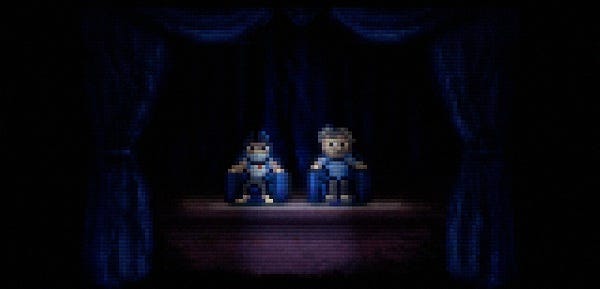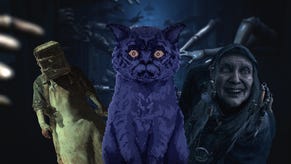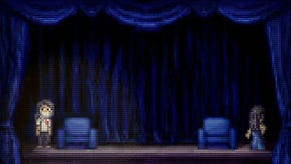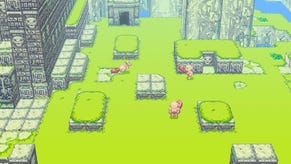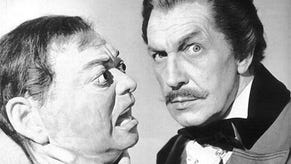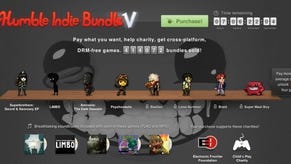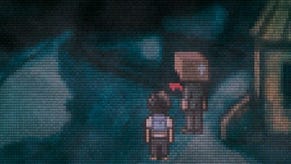Building Fear: Lone Survivor Interview Part One
Silynch Hill
In the first part of a sprawling conversation about his spectacular indie horror adventure, Lone Survivor, sole creator Jasper Byrne talks about the development process, audio and visual design, and some of the inspirations that went into creating the sinister and sentimental nightmare. There's nothing that should spoil the game for those who haven't played it. Thematic analysis and further love for David Lynch shall be expressed in a spoiler-laden continuation, which is coming soon.
(a rambling and irrelevant two minutes that ends on the difficulties of emigrating to the US)
RPS: Which leads us to the first question. Is Lone Survivor a post-9/11 game?
Byrne: Yes! It is. That’s the way, get right to the core. Yeah, it is, although maybe I shouldn’t say that. Not many people have mentioned anything to do with where it’s set or what the main event really is in the game.
RPS: Is that because of intentional ambiguity on your part? Do you want people to be asking those questions?
Byrne: I do, yeah, I do. I especially like it when there’s room left, in a movie or whatever, for interpretation. For peoples’ own…leaving a few gaps for people to fill in for themselves. Then the story can maybe adapt to the person that’s experiencing it. Especially in an interactive setting.
RPS: So you think it’s something that works particularly well in gaming?
Byrne: Yeah, it’s something I’m really interested in exploring. Trying to have a slightly personal experience for each person and how that works with narrative, with more traditional narrative. I’m really interested in that.
I think that’s what I was trying to do with this game. Looking at David Lynch’s films which are obviously a big influence, he does that deliberately. He has a very specific explanation in his head, I think, for each movie that he makes, and a very specific set of meanings for each scene and everything.
He might start with some crazy idea of a scene that he wants to do and work back from there, but eventually the whole lore will be there in his head. I was trying to do that and makes sure from the start that I knew exactly what the character’s life events were and what was driving him, and what the themes were. But then to deliberately bury that in the sand and not tell anybody. Obviously I’ve told a few friends because I had to have some help and input…
RPS: Sometimes when you obfuscate things too much yourself, you don’t realise how far an audience will be from understanding anything you’ve done.
Byrne: That’s it. At a certain point you don’t even know what you’ve put in there.
RPS: You eventually become your own worst audience.
Byrne: Some of the connections might still be in your own head. You might not have actually put them in the work at all and that’s fine with some of them, some are implied. There are a lot of things in the game that I don’t say specifically but they are in my head.
I think the idea of not sharing that with anybody and letting them have their own opinion is important. It’s a game that benefits from not knowing too much about it going in.
RPS: I told people not to watch the trailer, even though it’s a very cool trailer.
Byrne: I felt it was a double-edged sword.
RPS: The Cabin In the Woods seems a little hamstrung by its advertising. They clearly want to communicate to people that it’s not just a horror movie, that something else is going on, but as soon as they do that they tip the audience off to what’s happening.
Byrne: It’s so hard. During development, somebody got in touch with me looking to put Lone Survivor forward as an alpha funding project, ala Minecraft. I guess they had heard whisperings of food crafting and those kind of mechanics. I think they thought it was a zombie sim, more like Project Zomboid or something like that, and I just couldn’t believe that anyone wanted that from me, because it was so story-based.
I don't think that people really knew what the game was about at that point at all, because it’s not the kind of game that you can do that with at all. I had to keep it entirely secret right up until the day it launched.
RPS: I think that the word 'survivor' immediately reminds people of that sort of thing these days…in gaming terms the word has changed in meaning, it doesn’t necessarily mean ‘survival horror’ anymore.
Byrne: That’s interesting. At the time, I wanted to choose a name that was almost a parody of Fatal Frame or Silent Hill. It was deliberately cheesy. But that word survival has become associated with other games since then.
RPS: But it does have that sim element to it. I think when I first played it I was surprised by how much there was. It’s the part of the game I probably explored the least – I didn’t even work out how to make coffee. During development you kept tweeting about getting the coffee right and at the end I was thinking, ‘man, he took all the coffee stuff out!’.
Byrne: I was spending whole months on things that people will never see on any playthrough. It’s a very wide game. A few people have complained about the length but then they’ve described their playthrough and they missed almost everything.
I was going to say, the game really changed based on your article.
RPS: The really early one?
Byrne: Yeah. You didn’t really know anything about the game at that point.
RPS: No. And yet still I wrote.
Byrne: At that time, I thought I’ve put out a trailer that makes it look like a really gory, nasty, unpleasant game. And I thought, ‘that’s not me at all’. I actually felt slightly dirty at times.
Partly because you’d played it up in the way you described it and sort of made it…well, that’s what the trailer was trying to do and I realised I’d maybe provoked a stronger reaction than I planned.
So at that point I started to reconsider the game and that was actually when the stealth started to come in and all the other sidequests and nice things to do in the game. I felt like I needed a balance to counterpoint the dark side of the game.
So this whole extra element came in. Originally it was a normal survival horror game with all these extra nasty things you could do to shortcut your way through it. But I started to realise there was a whole other side to it; nice things you could do to maintain your sanity, to go the other way. I hadn’t even considered that at that point, so I think your article had a big influence on the game!
RPS: That’s what I like to hear! The idea of somebody surrounded by terrible things, surrounded by horror, who is actually trying to do good is much more interesting. And I think what I like about the character in Lone Survivor is that he’s not trying to do good for anyone else in particular, he’s just trying to do good for himself. There’s something quite sweet about that. It makes him so fragile.
Byrne: It’s definitely a reflection of how I was feeling at the time. Working on this for so many years, my money was running out, I was exhausted, tired. I knew that if I didn’t carry on at that pace, or maybe even a higher pace, I’d never get finished.
It started to go all a bit ‘Adaptation’. All the things that were going on in my life started going into it – the coffee and all that stuff is my daily routine of making the game. Adopting a cat – my daughter really likes this cat that lives around the corner that we’re always going to see. And my wife and I adopted a little white one in Japan when we lived over there.
So it was all based on things that were happening to me. Like the fact that you can’t drink coffee more than once a day without it being bad for your health – well, I make a massive six cup espresso in the morning and that’s my cup for the day. But if I make the second one I get the jitters and the afternoon is a bit of a mess.
RPS: Hopefully you then don’t have to take pills to calm yourself down.
Byrne: (laughs) That’s the other thing. Nobody’s quite got exactly what the pills represent in the game.
RPS: Talking about horror as a genre makes me realise how little of the whole gamut I actually enjoy. It’s my favourite genre but most of it is trash.
Byrne: Exactly! I don’t actually enjoy many horror films and they are the psychological ones in general. There’s the odd kind of visceral thriller that I enjoy. I mean, I love Halloween, but that’s still got a lot of psychology in it; it’s disturbing on a human level rather than a gory level.
RPS: There’s a big difference between a game, or a film, that terrifies you as opposed to unsettles you. Lone Survivor is certainly unsettling.
Byrne: There are no outright jump scares or buckets of blood flying everywhere. It’s all quite tame really. There’s a few gory walls but shooting a zombie doesn’t produce lots of blood, or lots of gory particle effects. It’s not going for that really.
The weird thing about the background art is that it actually looks gorier than it’s supposed to be. The mind fills in the blanks. I tried to use that. Drawing things that were rocks but looked, in the dark, like intestines.
RPS: The basement feels like walking through someone’s innards.
Byrne: But if you look at the actual pixels, it’s rocks and moss.
RPS: The sound design, which is probably my favourite part of the game, from the party scene and the shift in tone there, and the audio is probably the most intensely frightening thing in the game. You have a background in music, which many people may not know about?
Byrne: It’s a huge part of what I do. It was my job for ten years, so when I start thinking about a game it’s as much, in my head, the sound that comes, as much as the design or the art or whatever. Straight away I imagine how it’s going to sound.
I wasn’t actually going for a Silent Hill type sound in this game, but people have said that it’s along the same lines. I think it just turned out that way. The monster sound itself is one of the ones that took the longest. I kept going through different versions. I had a bit of inspiration when I was trying to work and my wife was hovering and I couldn’t concentrate, it was piercing my head, so I took that hoover, electric drill sound, and thought that’s the most uncomfortable sound at this particular time, when I’m deep in some horrible bug or something. So I started moving away, because originally it was much more animalistic, organic, pig sound almost (makes a very passable pig sound)...
A scrunchy kind of sound. Eventually, by the same thought process that they probably went through on Silent Hill, I thought what is the most uncomfortable sound you can hear, that sort of grinding that actually hurts to listen to. You want it to stop!
RPS: It’s as easily compared to Silent Hill as to Lynch again. He’s a master of sound.
Byrne: When he takes one tiny sound and it’s just building, very gradually louder. Like that great scene in Mulholland Drive when they go around the back of the diner and there’s just this one note, playing very quietly at the beginning and at the end there’s this sort of distorted BWAAARRGHHH.
RPS: And then it’s muffled as if you’ve been deafened.
Byrne: There’s a similar one in Twin Peaks when Bob comes toward the camera. There’s not even that much going on in the sound, it’s just well chosen.
RPS: In your sound, the thing that differentiates it from a lot of horror, is that you go through a lot of different moods. It’s not constantly oppressive.
Byrne: Yeah! It’s got some upbeat tunes in it, some happy moments and comedy moments. I can sort of see some ambient trip-hoppy jazz in Silent Hill but not full-on weird jam blues, jazz thing going on. That’s much more from the movies that I watch.
I guess the music has kind of happened over the three or four years that I’ve been making it, so it’s kind of how I’ve felt at the time. I finish a scene and feel like it needs a new piece of music so I write that. It’s all been really instinctive in this game.
With my last game, Soul Brother, I set out to do a very specific style from the start and make it very consistent across the game. With this one I wanted it to be a bit more like a movie, so like the director listening to tunes on the way home and picking out one for the scene you’re doing at that time…
RPS: But from your own head!
Byrne: I wanted it to sound like they were all different artists. So it was like I was just picking out an old jazz tune I liked, then an old trip hop tune that I liked. Just something that felt right for the scene.
RPS: I imagine there are people who think it’s from a lot of different places. Particularly when they’ve played all the way through.
Byrne: The mixing is different as well, in all the tunes. It’s a way of cutting corners but it was also a conscious decision. I didn’t want to go and heavily master the album like with Soul Brother. I almost wanted it to sound a little bitty, sort of like each song had been recorded in a different place.
I guess that was to try and make it more movie like in a way. Don’t get me wrong, I’m not David Cage, I’m not trying to make Heavy Rain. But I think there are a lot of things that movies do that games haven’t picked up on or taken advantage of yet.
RPS: It’s strange that when people use the word ‘cinematic’ to describe a game they mean a slow motion action sequence.
Byrne: Yeah!
RPS: I’ll put a link to the different visual styles you worked through, but what made you settle on this one in the end?
Byrne: It was partly economy and I kept doing smaller and smaller resolutions. I started doing pixel art to get games done quickly because I was working on other things at the time, music initially and then in the industry.
And then I realised there were people who appreciated it for what it was. Like me. I thought I was in a minority there but as it’s gone on it’s become an acceptable way to present things. A stylistic choice. The technical stuff in this game is actually quite complicated. I didn’t really cut corners in that sense. It gives you two things: a quicker way of making art and a lot of room for interpretation.
I guess we’re going to have to touch on the whole mask/smile thing! (laughs)
RPS: That was going to be my last question. Did you never see it during development?
Byrne: No! I never saw it! Obviously, everyone told me and I thought ‘great’, that’s something about pixel art that I like. That it leaves that space for interpretation. If you look closely it doesn’t look like a smile!
RPS: When I posted the first trailer I hadn’t recognised that but saw a comment elsewhere, somebody saying ‘has he got a massive shit-eating grin’? I thought wait-a-minute…
Byrne: It wouldn’t have bothered me at all if it hadn’t been nine comments out of ten being about that! (laughs)
Like I was saying about the gore before, is it an intestine or is it a wall, I think that’s a really cool aspect. It’s one of the things that’s really cool about those PS2 survival horrors; they leave a lot of space for you to fill in the gaps.
I think that’s one of the key parts of horror really. Leaving what the audience imagines, which is a lot scarier than what I can ever show. Pixel art actually does that surprisingly well but I think people have always portrayed it quite cutely, because it’s somehow minituarised. Automatically people will tend to go for a super-deformed look, with a large head and big eyes, to read better. I’ve tried to go for semi-realistic proportions and things, and without bouncy Mario style animation, without the squeeze and squash. It’s all quite wooden and stiff.
If people had done that more at the time, there could have been a whole genre of quite scary games, but I don’t think anybody realised…and it does really help to have the modern tech for lighting. Those two things together, the art being quite mysterious and all the processing on top adding this noise. Because each frame you see a slightly different image, specks and things jittering in the corner, that’ll set your imagination running.
RPS: For all that I said about narrative ambiguity, I think that I sometimes work too hard to understand narrative and this is a mood piece as much as anything.
Byrne: Let things wash over you and the interpretation can come from feeling.
RPS: It’s something we’re very happy to do with a painting perhaps or an album, but not so much with a game or a movie.
Byrne: There’s also that segregation between art games and game games. I see that both can learn from each other. I don’t try to make stuff that is art game or mainstream…well, in a sense I am trying to make a mainstream game because I’m doing it on my own, so that’s inevitable really.
I don’t see why mainstream games don’t reach a little further with their writing and I don’t see why the art games don’t reach a little further with their mechanics or accessibility. Make them more compelling.
RPS: You probably see more of these trends, being part of the indie scene…although you’ve probably been outside it for the last few months in crunch!
Byrne: I’m actually a bit of an outsider. Having a wife and kid I don’t get to jam so much, or hang out with the other indies so much. I haven’t been to GDC or these other events. What I do is outsider stuff, me trying to copy games that I love and making things that are different because when one person makes a thing alone, all of those hangups and personal things go into it.
RPS: That may be part of the appeal of auteur theory. Lots of people collaborating but one person imposing a vision.
Byrne: All my favourites tend to have an auteur behind them. ICO, Dark Souls. There’s someone who is so strong in guiding it that their personality is all over it. I’m very much for that. It’s sort of why my favourite games are by a company with one incredibly strong, or by an indie like Cactus, thecatamites or Terry [Cavanagh].
It’s a sort of dictatorship but it’s sometimes the only way it can work. It’s very rare to have two directors collaborate on a movie or a book collaboration that’s better than a solo work.
Check back later this week to read the thoughts of two men who enjoy surrealism and psychological horror far more than is probably healthy. And if you've played the game, maybe some of your lingering questions will be answered. Read my thoughts on the game here and buy it direct from Jasper, DRM-free. The excellent soundtrack is also available for purchase.
